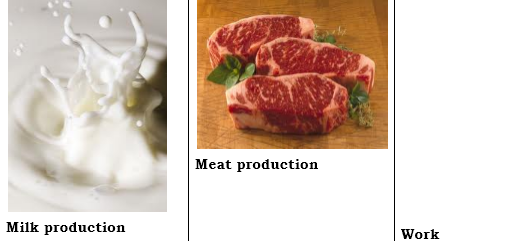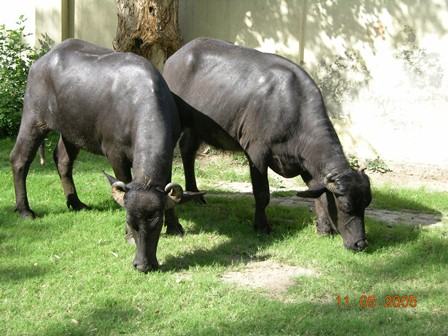About Buffaloes
Back
About Buffalo
• India, a country of the world largest buffalo population, accounted 53% of the world total with an annual average increase rate of 1.1%
• In India, water buffaloes make up about 35% of milk animals (other than goats) but produce almost 70% of the milk.
• Buffalo butterfat is the major source of cooking oil (ghee) in some Asian countries. In the US, they have been introduced as an “exotic” livestock with developers hoping to build a market for the distinctive mozzarella cheese and low cholesterol meat.
Classification:
Buffalo are classified into two distinct classes: swamp buffalo and river buffalo.
Swamp Buffaloes:
• The swamp type is most common in Southeast Asia where it is mostly employed as a draught animal, particularly in rice cultivation. It has derived its name from the natural habitat which is swamp or marshland.
• Swamp buffaloes have a very low milk yield and are not used as milk producers. However, crossings between river and swamp buffaloes have been attempted in Thailand, Philippines, Vietnam, and China on a large scale.
• These crossbred buffaloes are powerful work animals, and produce good quality meat and more milk than the indigenous buffaloes

River Buffaloes:
• The river buffalo is the most common type in India, Pakistan, Bulgaria, Hungary, Turkey, Italy and Egypt. They are also found in Brazil and Caucasia. The river buffaloes are massive in size mostly with curled horns, prefers to wallow in clean water and rivers, thereby the name.
• River buffaloes have been selected for milk production to a larger extent and some river breeds. E.g. Murrah, Nili-Ravi and others are solely used for milk production.
• India, Pakistan, Italy and Egypt have a widespread culture of consuming buffalo milk. These countries are the most prominent in research on buffaloes.

Utility of Buffalo

Milk production
• Buffalo are the second largest source of milk supply in the world.
• Trends in world milk production over years indicate that the volume of buffalo milk is increasing steadily at about three percent per year.
• While dairy cattle produce 84% of the total milk in the world it has to be noted that this volume is with an average fat and protein content of 4% and 3.5% respectively. The average fat content in buffalo milk is about 7 to 8% while protein content in buffalo milk ranges from 4.2 to 4.5%. So in terms of energy corrected milk, buffalo milk is making a greater food contribution than the actual volume of buffalo milk suggests.
Meat production
• Buffalo have been used as draught animals for centuries. This has lead to exceptional muscular development: some animals can weigh more than 1000 kg. Though buffalo are a major source of meat, they have not been used solely for meat production until recently.
• Most buffalo meat is derived from old animals so not surprisingly the meat is considered to be of poor quality. However this is not true of meat from younger animals. Buffalo meat from animals properly reared and fed, is tender and palatable.
• Buffalo are lean animals. In general, a buffalo carcass has a higher proportion of muscle and a lower ratio of bone and fat than a cattle carcass.
Work
• The water buffalo is an important beast of burden in Asian farming. It is widely used to plough, level land, plant crops, puddle rice fields, cultivate field crops, pump water, haul carts, sleds and shallow-draft boats. It is also used to carry people, thresh grain, press sugar cane, haul logs, and more.
• Buffalo have an advantage over other draught animals in wet or muddy areas, with their large hooves. Their legs can withstand wet conditions better than cattle. However they are not as fast as cattle, horses or mules. This puts them at a disadvantage in dryer areas.
Behaviour

Feeding behaviour:
• Buffaloes are strict grazers and only browse when feed is utterly scarce.
• Normally, buffaloes graze during the day. In case of extremely high ambient temperatures, grazing takes place in the morning and afternoon and sometimes during night time.
• Buffaloes graze more and better than cattle. Thereby they consume more feed and nutrients per kg of body weight than cattle do.
• Newborn calves suckle their mothers within two hours of birth. Normal suckling frequency is approximately 6 to 8 times per day. The calves start to nibble grass at 3 to 4 weeks of age, although they are not actually grazing until after a few weeks more.
• When the calves have reached two months of age, forage starts to become more important than previously and soon most of the nutrient intake comes from forage rather than milk.
• Natural weaning of calves is usually within a year or before its mother’s next parturition.
Wallowing behavior
• Wallowing has two purposes; the most obvious is that of cooling, the other is protection from insects.
• Wallowing during daytime is done during the hottest hours. Wallowing during night time is instead a way for the animal to protect itself from insects.
• The buffalo has few sweat glands and a dark skin which makes it difficult for them to maintain their body temperature in hot and humid environments. Wallowing is a very important way for the buffaloes to maintain their body temperature.
• When buffaloes enter the water, they defecate and/or urinate. This seems to be a way to mark their wallow.
• Wallowing behavior is a learnt behavior. An animal that has not wallowed from birth with other animals will not do so on its own. Teaching such an animal to wallow is almost impossible for humans. The buffalo has to learn it from other buffaloes, even so, the adult buffalo will be very suspicious and may not wallow by its own choice.
• If no water or mud hole is available, the buffaloes behave more like cattle. They will seek shade and graze more during the cool hours and less during the hot hours.
Communication
• The most important way among buffaloes to communicate is by smell. The buffaloes recognize each other by smelling each other. Smell is used when marking a territory. Buffaloes will rub themselves against trees to leave scent and they defecate to mark their territory.
• Vocal communication is important especially from calves. There are both friendly and hostile vocal communications.
• Posture is important when deciding rank and dominance order. A threatening animal will lower and shake its head
Breeding behavior
Males and females live in separate groups. They will merge in the beginning of the wet season for mating. The bulls can detect females in heat by their scent and find their camp. There is a period of foreplay before the actual mating takes place. This period is 1 to 3 days and allows the animals to get to know each other. The bull will not leave a female in estrus and he will not allow another bull to come near her. Only the most dominant bulls will mate.
Mother-calf behaviour
• There are very strong bonds between the mother and her calf.
• If the calf is a male, the bond holds for approximately 2 to 3 years. Thereafter the calf is driven from the clan.
• In the case of a female calf, the bond exists for life. Shortly before parturition the mother moves away to give birth alone. Within 30 minutes after the calf is born all members of the clan has “inspected” the newborn and touched it with their noses. Nearly all members of the group have come from this inspection. This inspection seems to serve as an introduction of the newly born. It also facilitates adoption of the calf if the mother dies. Adoptions always occur among buffalos whereas it is hardly seen in other species.
• The calf walks with its mother as soon as it can stand. This behavior is different from cattle where the cow leaves its calf to go grazing.
• Nursing of the calves is common among buffaloes. The calves are left with a “care-taking-animal” who is often a female, but seldom a young bull. The other females go away to graze and leave their calves. Should there be a threat to the calves, they will simply call and their mothers will come running to their aid.
